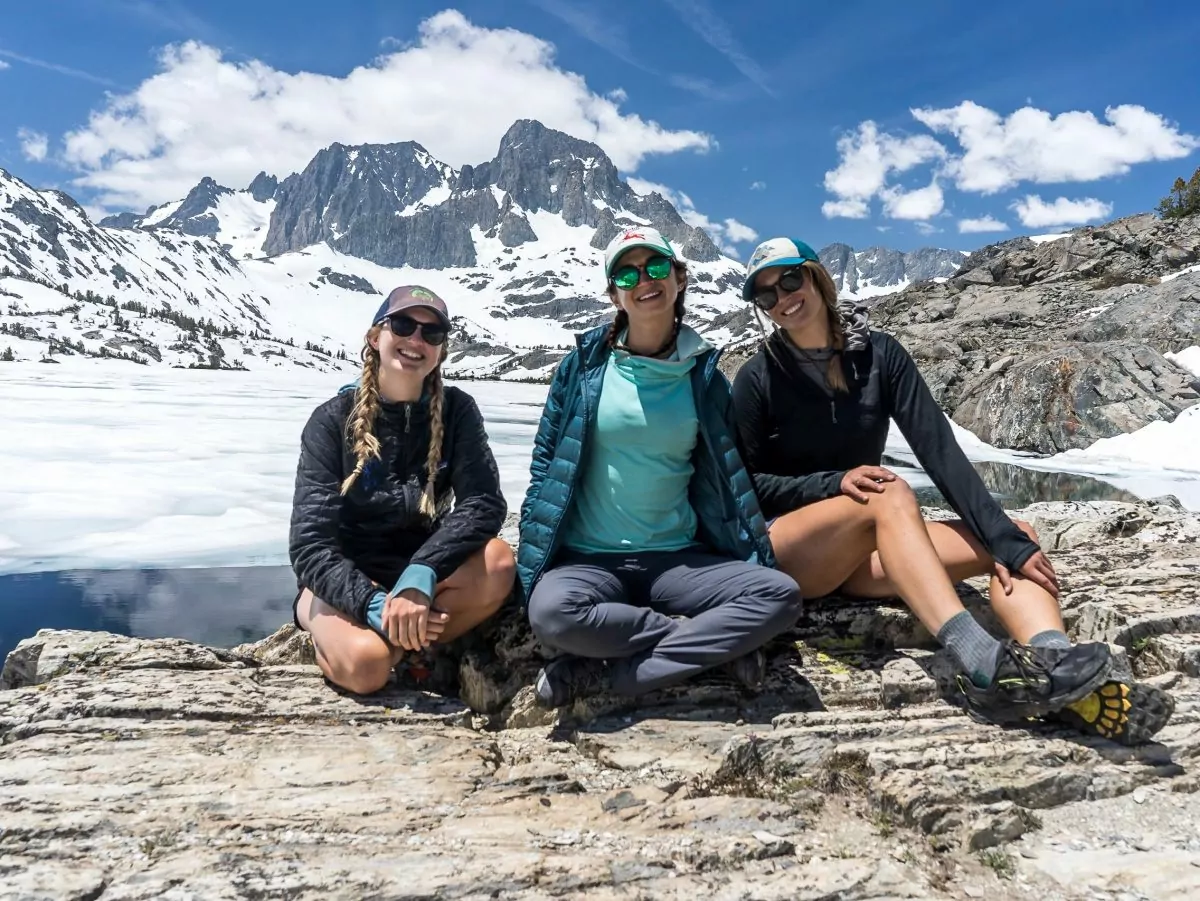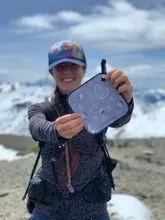Feminine Hygiene while Backpacking

For a first time backpacker, maintaining adequate feminine hygiene may be a source of anxiety. Likewise, dirtbag veterans may wonder about improving their hygiene game for future adventures. The good news is staying clean in the backcountry is actually pretty simple, leaving your mind free to tackle other logistics (like determining the proper number of Snickers bars to pack per day). Having a plan for your daily hygiene, toileting, and menstruation will help you hit the trail with confidence.
guided women’s adventure Trips
Backcounty Hygiene: Daily Tips
Despite popular belief, staying on top of cleanliness on the trail is absolutely achievable. Sure, you will still be a considerable degree dirtier than you are in your typical life, but that is a part of the experience! For your own sake though, keep your hands and your “downstairs” clean. Here are a few strategies to help achieve this feat:
1. Go for a Swim
You are heading out for a Yosemite Alpine Meadows and Waterfalls trek? Great! You will have absolutely no problem keeping clean as you can swim in the refreshing river water every day. It is totally normal and encouraged to give yourself a little flush while out for a swim. Consider this an extra incentive to jump into that cold water! I promise, it will be worth it.
2. Consider Wet Wipes
Disposable wet wipes are definitely the most common way to keep fresh in the backcountry. This is a particularly important method if you are heading into a dry environment such as Joshua Tree National Park or on a winter trip in the Smoky Mountains. While wipes are pretty simple, there are a few considerations to keep in mind.
- Wet wipes are actually pretty heavy. Do not bring a pack of 100 wet wipes on a four-day trip. Take out the number of wipes you will need and repackage them in a clean, sealable bag. One wipe per night is plenty for feminine hygiene. You may want to add one more wipe per night for your face. More than two or three wipes per day is getting into the realm of excess. You do not need to clean your entire body with wet wipes, just the important bits.
- Ensure you are disposing of your wipes appropriately by keeping a sealable plastic bag available for trash (a reused Ziplock is great for this purpose). Wet wipes should absolutely never be left on the ground, in a hole, nor should they go into pit toilets- even if the package says they are flushable. Pack it in, pack it out!
- For a more environmentally friendly option, consider purchasing compostable wipes. Use a separate trash bag for them and then compost when you get home. You could also make your own reusable wet wipe using a small cloth and clean water. Just make sure you will have reliable water sources throughout your trip as you will want to rinse the cloth out each day.
How to Poop while Backpacking
A backpacking trip means peeing and pooping outside. Woo hoo!
Pooping in the backcountry is actually pretty straightforward. In most cases, you will be using toilet paper to clean yourself up. Like wipes, toilet paper should never be left on the ground or buried. ALL toilet paper (yes, even your poop paper!) must be packed out in a sealable bag and disposed of in a garbage can. It really isn’t as gross as it sounds. If that image is just too much for you, consider checking out backcountry bidet options. Additionally, some people forego toilet paper in lieu of natural items, but we recommend just getting comfortable packing out your TP.
For your toilet paper system, we recommend carrying a durable gallon Ziploc bag as your bathroom kit. Inside, you can keep a smaller Ziploc bag for your used toilet paper. Some people prefer to use a blacked-out bag, where you tape the inside with duct tape so you can’t see its contents. Whatever makes you feel comfortable!
how to poop outdoors
In most areas, like the old-growth Pacific Northwest forests and the hardwood Great Smoky Mountains, you can use the cat-hole method for pooping. Walk at least 200 feet from any trail, camp, or water source, and then dig a cat hole six to eight inches deep. Follow these leave no trace human waste tips for selecting a site to make the process easier!
In certain fragile areas, like desert and alpine environments, or areas with high traffic, you need to carry out all human waste — including your poop. In these instances, you’ll need to use a wag bag. Before you embark on a backpacking trip, be sure to check the requirements of your area so you’re leaving it better than you found it.
Peeing while Hiking for Women
What to do after peeing is even more customizable, especially for women.
Toilet Paper

After peeing while hiking, some folks prefer using their trusty toilet paper. Frankly, this is not an ideal backcountry method. You need to allot yourself the appropriate amount for your trip, including what you need for pooping, without bringing an excessively massive roll. Furthermore, estimating TP amounts can be tricky because you may urinate more than normal while backpacking.
Again, used toilet paper must be packed out. Keeping your “dirty toilet paper” bag minimal is the goal. The more paper you use, the more dirty paper you carry, the bulkier the bag, and the more often you have to open it!
“drip dry”
The Drip Dry method is a time-honored tradition by those who do not stand to pee on trees. This means after peeing behind a bush (remember, always at least 200 feet away from trail and water sources) you just simply give a little shake and go, sans toilet paper. This is convenient and simple. The drawback is that your undies, and therefore your shorts/pants, will definitely get dirtier faster. This may not be a great method if you are concerned about not feeling fresh throughout the day.
pee cloth
 If you don’t like the idea of Drip Drying, but you also don’t want to carry more used toilet paper than you have to, a pee cloth is a great option. The idea is simple: instead of using disposable toilet paper after you pee, you wipe with a reusable cloth instead. (To be clear, this is ONLY after peeing—grab the toilet paper and your TP trash bag when you poop.) After you pee, you can hang this cloth on the outside of a pack, exposing it to fresh air and UV during the day. Give it a rinse as often as you feel the need (always downstream of where swimming or water collection may occur). You generally don’t need to use soap (and if you do, wash the pee cloth away from any water source—yes, even if you’re using biodegradable soap.) If you still aren’t sure about the whole Pee Cloth idea, check out this instructional video made by the Leave No Trace Foundation.
If you don’t like the idea of Drip Drying, but you also don’t want to carry more used toilet paper than you have to, a pee cloth is a great option. The idea is simple: instead of using disposable toilet paper after you pee, you wipe with a reusable cloth instead. (To be clear, this is ONLY after peeing—grab the toilet paper and your TP trash bag when you poop.) After you pee, you can hang this cloth on the outside of a pack, exposing it to fresh air and UV during the day. Give it a rinse as often as you feel the need (always downstream of where swimming or water collection may occur). You generally don’t need to use soap (and if you do, wash the pee cloth away from any water source—yes, even if you’re using biodegradable soap.) If you still aren’t sure about the whole Pee Cloth idea, check out this instructional video made by the Leave No Trace Foundation.
There are both commercial and DIY pee cloth options available. Kula Cloths have a great design with an antimicrobial “wiping” side and a waterproof outer for handling. They also rock a huge variety of fun prints and clip-closed for privacy and cleanliness.
A DIY pee cloth can be as simple as hooking a bandana to your pack or tying a long strip of microfiber cloth to a loop on your pants. If you are going this route and you are borrowing a backpack from Wildland Trekking (or a friend, for that matter), please check in with your guide with how they want you to store your pee rag in the field. They are going to be cleaning your pack at the end of your trip, so it is considerate to know their preference.
Menstrual Care in the Backcountry
Periods in the backcountry are not ideal but they certainly are not a reason to stress or cancel a trip. If you use medications to ease menstrual symptoms at home, it is a good idea to bring them on your backpacking trip. A hot water bottle held to the stomach is also a great way to reduce discomfort while in camp. As for the bleeding, let’s break down options for dealing with it.
Tampons and pads
Like toilet paper and wipes, tampons and pads must also be packed out (see a pattern here?). Used materials can go into your dirty toilet paper bag or a separate trash bag. This will lead to a very significant amount of waste by the end of a multi-day trip. Other than that though, use as normal.
menstrual cups
Menstrual cups are a game-changer for backcountry travel. Once or twice a day, depending on flow, a menstrual cup just needs to be tipped into a 6-inch deep cathole and rinsed with water. That’s it! No extra trash and, bonus, it is easy to swim with.
If you have never used a menstrual cup, we highly discourage you from taking your cup on its maiden voyage on a backcountry trip. There can be a bit of a learning curve, so try it out a few times at home to get comfortable before hitting the trail.
period underwear
Period underwear is made of superabsorbent material, catching menstruation and allowing free flow. Like menstrual cups, this is a no-waste option. We recommend rotating between two pairs for convenience and space-saving. When washing, never contaminate a water source by dunking your undies in. Use a container to bring water 200 feet away from the source. Rinse the undies and then dry them on your pack, in the sun during lunch, or at camp. Depending on your comfort level, you may prefer a new pair for each day. For a multiday backpacking trip, more than two pairs will probably start to fall into excessive packing territory; not to mention potential odors if they are stored without washing.
Be Prepared and Have Fun!
While part of the fun of a backcountry trip is getting your hands dirty (your whole body, really), it is also important to be comfortable and confident. Before hitting the trail, think about your options for daily hygiene, toileting, and menstrual care. Pick a plan that feels right to you and set yourself up for success. Most importantly, just get out there and have fun!
And if you’re nervous, join a guided women’s backpacking trip! These women-led excursions can be a great way to experience the wilderness while feeling comfortable talking about periods, diva cups, and a lot more.
guided women’s adventure Trips


